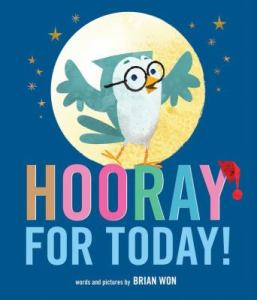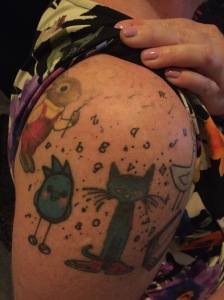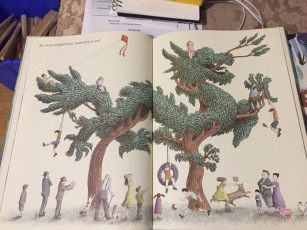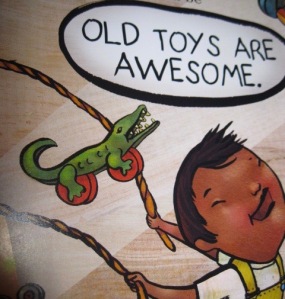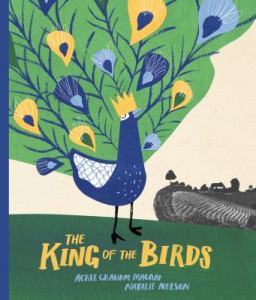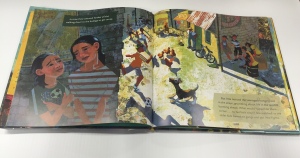2016 Picture Book Month, Week Five
Four more for the last of Picture Book Month! The first two books are fine pre-school storytime choices; the last two can be shared with older children and will certainly garner discussion.
Hooray for Today! by Brian Won
The story of an owl that is not sleepy at night and keeps all her friends awake is nothing new. But Won’s cheerful retro-style depiction of this story is one that will be welcomed for storytimes at the library and at home. Pair it with Won’s Hooray for Hat for a big Hooray party.
A Hop is Up by Kristy Dempsey, illustrated by Lori Richmond
Verbs and adjectives and thick lines — this easy-to-read romp with a friendly dog will be a fun addition for early-readers and for doggie-themed storytime. Grab this one for toddlers or your classroom and explore language and movement as you enjoy the ink & watercolour art.
Home at Last by Vera B. Williams, illustrated by Chris Raschka
This is one to share one-on-one or with a small group. Williams’ last book before s he died will not disappoint her fans; this is another insightful, loving story of childhood. An orphaned boy is adopted by two dads. Life is good, but unsettled, until Wincka the dog saves the day. Raschka and Williams collaborated on this, and it shows in the warm watercolour art. There’s an audience waiting for this story, and those who find it will be moved.
he died will not disappoint her fans; this is another insightful, loving story of childhood. An orphaned boy is adopted by two dads. Life is good, but unsettled, until Wincka the dog saves the day. Raschka and Williams collaborated on this, and it shows in the warm watercolour art. There’s an audience waiting for this story, and those who find it will be moved.
Last, but certainly not least, is Freedom in Congo Square by Carole Boston Weatherford and R. Gregory Christie. A seemingly simple poem about a very complex issue, this book is a history lesson about  slavery and oppression, yet also a paean to the human spirit. Christie’s folk-art inspired paintings set the tone, and show the backbreaking work that Louisiana slaves endured. One scene shows the slaves in their cabins, recalling drawings of slaves packed into ships. This is not a happy-go-lucky preschool storytime book. It addresses mature themes, as one would expect. But is also shows the joy experienced, ever so briefly, once a week: look at this dancer, swaying to the rhythm of
slavery and oppression, yet also a paean to the human spirit. Christie’s folk-art inspired paintings set the tone, and show the backbreaking work that Louisiana slaves endured. One scene shows the slaves in their cabins, recalling drawings of slaves packed into ships. This is not a happy-go-lucky preschool storytime book. It addresses mature themes, as one would expect. But is also shows the joy experienced, ever so briefly, once a week: look at this dancer, swaying to the rhythm of  music. The first part of the book is all stiff shapes and hard lines. In Congo Square the lines become fluid, the movement changes, the art dances. The colours in this part of the book are yellows and oranges, warmth and light. The art in this book is amazing. It dredges up uncomfortable images, and then shows us joy. The Forward, Glossary, and Author’s Note extend the short text, making it a very teachable book. The paintings extend the story even further, putting unforgettable images into our minds and hearts. **Side note- -this one has taken the lead in my current favourite for Caldecott. It is scooting Ada’s Violin over to second place.
music. The first part of the book is all stiff shapes and hard lines. In Congo Square the lines become fluid, the movement changes, the art dances. The colours in this part of the book are yellows and oranges, warmth and light. The art in this book is amazing. It dredges up uncomfortable images, and then shows us joy. The Forward, Glossary, and Author’s Note extend the short text, making it a very teachable book. The paintings extend the story even further, putting unforgettable images into our minds and hearts. **Side note- -this one has taken the lead in my current favourite for Caldecott. It is scooting Ada’s Violin over to second place.
That’s it for this November… but there will be more picture books to come, and next November will once again be Picture Book Month!

